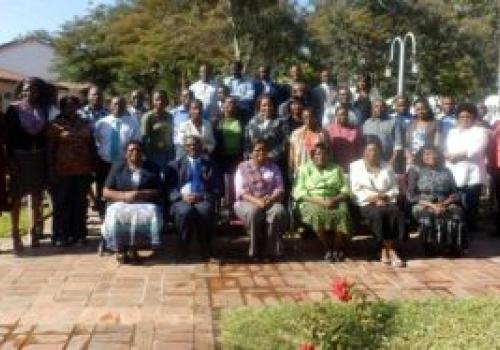Forty-five high ranking Malawi Officials, attended a five day trainer-of-trainers workshop from the 27th to the 31st May 2013, at the Sun and Sands Resort in Mangochi on the shores of Lake Malawi. The impact of the gender and the culture on the development of the HIV epidemic was debated.
The meeting agreed that the positive and negative aspects of culture on HIV should be documented and shared within countries and amongst Member States. However some cultural aspects are protective, such as family cohesions and sexual reproductive educations by aunts and grandmothers.
One of the most important aspects of the training of trainers was the problem tree analysis, which looks at roots and causes of HIV, including its impact on sectors and the development Agenda. Many exercises were organised. The participants raised the question of circumcision and an assessment of culture as a determinant or protection on HIV was conducted.
The HIV epidemic in the SADC Region is a feminised epidemic; females are more affected and infected. It is also driven by stigma and discrimination on status of infection and sexual orientation and marginalisation.
Because of this the region agreed on mainstreaming HIV with a gender and human rights sensitive approach. Some cultural beliefs play an important role in transmission and in most cases most cultures perpetuate the belief that women are of a low status in society.
One of the cornerstones of the Maseru Declaration on HIV and AIDS of 2003, which was signed by 14 Heads of States and Governments of the SADC Region, is the multi-sectoral response to HIV and AIDS. By definition HIV is both a behavioural and development illness. This means that HIV not only has an impact on development but that development also plays an important role in the transmission of HIV.
Talking about the cultural impact on the HIV epidemic, some cultural practices were stated as Chinamwali which is an interesting aspect in the Malawi culture: whereas it is a passage rite it also encourages women to please men during the sexual act, further in the Yao culture after the chinamwali, the young girls have to be de-vaginated by one old man in the village who is paid to do this, as part of the practical aspect of the rites of passage. What if he was HIV positive? Could generations of girls in the village not be infected and would that not even increase the epidemic proportions?
In some parts of Zimbabwe and Namibia, when a son marries a women, his father is the first one to have sex with her before the son, this is called opening the way. Could this not also play a role in HIV transmission?
The exercise also looked at the positive aspects of HIV which people rarely discuss. These include economic benefits, discourse on the status of women in societies etc.
Another important exercise involved the so-called risk scenario; mapping out the risks to the individual brought about by their work place and the risks of the sector to the wider community. This exercise assisted sectors to respond accordingly and using evidence.
There was an interesting debate on the pros and cons of traditional circumcision and medical circumcision. Further it was felt that, Information, education and communication on circumcision does not explain why the traditional circumcision procedure does not protect the male from infection. Traditional circumcision procedures only remove the front part of the fore-skin whereas the medical circumcision takes away the whole fore-skin, this makes therefore medical circumcision more protective than the traditional circumcision. The meeting resolved that this piece of evidence should be part of the advocacy and lobbying approaches on male circumcision programs.
It is time that all sectors including those at the SADC Secretariat start mainstreaming cross-cutting issues such as gender, HIV and human rights into all their strategic and operational plans. This would reinforce the multi-sectoral approach promoted by the Maseru Declaration. Since every sector is involved in development, it means they have a place to play in the response to HIV, this is called Mainstreaming HIV.
The meeting was organised with funding and technical assistance from Deutscher Geselschaft fuer Internationale Zusamenarbeit: German Agency for International Cooperation (GIZ) and the Malawi National AIDS Council, and Technical assistance from the SADC Secretariat. The participants included civil servants, uniformed forces personnel, non-governmental organisations and partners.

